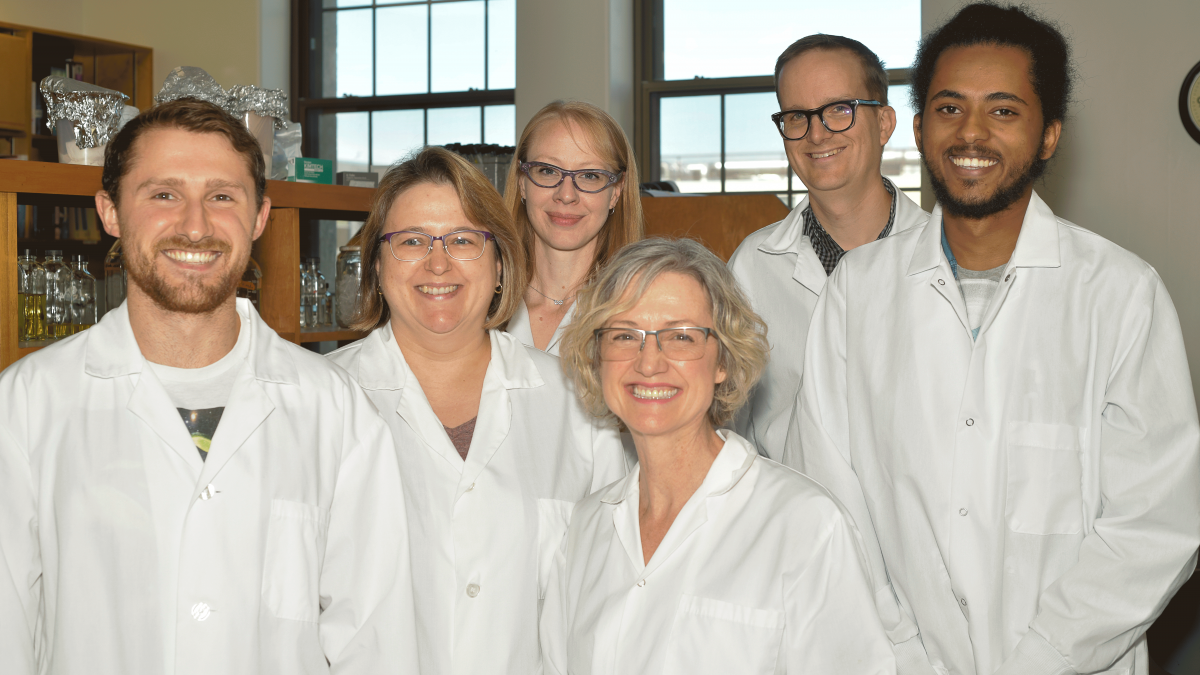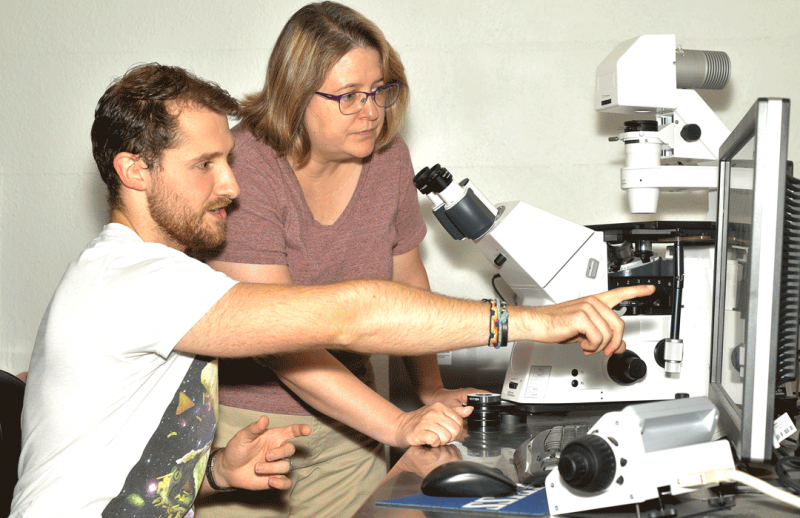
Image courtesy of Ricardo Blanco. From (L to R): Andrew Hogan, Ann Karen Brassinga, April Gislason (back), Dr. Silvia Cardona, Dr. Mike Domaratzki(back), and Haben Tesfu.
New antibacterial compound to combat cystic fibrosis infections
Dr. Silvia Cardona publishes results of cystic-fibrosis-related research in prestigious ASM journal
It’s a concept as old as time: cooperation. Individuals working together to reach a common goal. In the case of Associate Professor of Microbiology/Medical Microbiology Silvia Cardona, it’s a method that comes naturally.
“I think I was lucky that I always was inclined to interdisciplinary research. You talk to people from different disciplines, and you ask ‘do you know somebody that can help me with this particular aspect?’ But this is a key question: many times, you talk to people from other disciplines and you don’t understand each other. You use the same words, but with different meanings, and that is a problem. You need to be aware of that, be very clear when you talk to people from other disciplines, and then ask a lot of questions. That’s how all this came together.”
“All this” is Cardona’s latest collaboration with other researchers in Italy and Russia, as well as computer scientists right here at the UofM, and the resultant paper that’s been accepted by ‘Antimicrobial Agents and Chemotherapy (AAC)’, a journal published by the respected American Society of Microbiology. Entitled “Competitive fitness of essential gene knockdowns reveals a broad-spectrum antibacterial inhibitor of the cell division protein FtsZ”, the article itself not only documents the specifics of Cardona and her teams’ findings; it’s a testament to the power of collaboration and interdisciplinary research.
This tale of international cooperation began by chance. All three labs were focused on examining the infections prevalent in patients with cystic fibrosis (CF), with a view to developing new treatments. CF is a genetic condition which primarily damages the lungs, eventually leading to both loss of lung function and recurrent infection, ultimately causing death.
The Italian and Russian researchers had synthesized a compound with antibacterial properties that could kill CF pathogens. However, they were unable to understand precisely how the compound functioned. The role of Cardona’s lab was to determine how the antibacterial worked to disable Burkholderia cenocepacia, a particularly harmful bacterium that affects those with CF. A partnership was born.

Graduate student Andrew Hogan and Dr. Ann Karen Brassinga, using Axioobserver Z1 epifluorescent microscope.
Upon receiving the antibacterial compound from her international collaborators, Cardona gave the task of testing the substance to her PhD student, April Gislason. Gislason worked with a panel of mutants in order to discover which was more sensitive to the antibiotic. It was at this point that Cardona realized that she needed help to analyze the large amounts of data being generated by Gislason’s work. Cue Professor Mike Domaratzki, Acting Head of Computer Science, whom Cardona brought onboard to help her develop bioinformatics methods that would help discover more about how the compound worked.
Domaratzki is used to collaborating with researchers from other disciplines, and admits he finds it rewarding to be able to build a program that suits their specific needs. He notes that fairly often, scientists don’t know what questions they can ask of the computer scientists they’ve turned to for help.
“For me, this project is kind of cool because it takes the knowledge [the members of Cardona’s lab] have and the conditions they have and you express that in code. You’ve got to match that exactly. It turned out to be a fairly interesting series of conditions. It wasn’t as straightforward as it may sound, of just crossing things off a list. We had a bunch of stuff to check. And this was fun because I actually got to do it myself.”
Domaratzki says that most times when computer scientists are asked to collaborate with other researchers, they don’t get a sense of the full project, as their time is spent working on smaller, targeted pieces of bigger experiments. In this case, his goal was to narrow down the regions of investigation in the genome to try to find the right targets. The software was written with a view to processing large numbers of mutants quickly to eliminate those that were irrelevant.
Cardona affirms that it was a challenge to develop the scripts which would allow her team to understand the data they had collected. Her lab members’ knowledge of computer science wasn’t deep enough to build scripts to interpret their data. That’s where Domaratzki and his knowledge of bioinformatics came in.
In the meantime, Gislason was due to graduate. She trained fellow graduate student Andrew Hogan, teaching him what she had learned to that point. Cardona praises Gislason’s generosity in sharing her knowledge with Hogan and keeping the focus on the team’s ultimate goal. Hogan in turn supervised undergraduate student Haben Tesfu (now a Masters student in the Cardona lab), training him to determine the full spectrum of the compound’s antibacterial activity.
Yet another player in the story is Microbiology Associate Professor Ann Karen Brassinga, whose grant-funded Axioobserver Z1 epifluorescent microscope Hogan used in his experiments. Obtained in 2011 through the auspices of the Canada Foundation for Innovation (CFI), the Zeiss-manufactured equipment has been maintained since then through operating funds and user fees.
“Because we were able to keep it operational, we’re able to get quality high-resolution images to show the impact of the compound on the bacterial cells. So, it’s really through the generous support of CFI that we were able to get this microscope and be able to do all these experiments. I trained Andrew how to use the microscope and accompanying software, made some suggestions to optimize the imaging approaches, and he took it from there.”
Hogan, whose background is in biochemistry with “a little sprinkling of microbiology on top” is happy to be working with Cardona, whose lab he came to from his home province of Newfoundland. He was interested in her use of standard wet lab techniques in combination with new methods of sequencing and bioinformatics network analysis. It fell to Hogan to use Cardona’s “library” of Burkholderia mutants to test the compound, which is identified simply as C109.
“Essentially, it goes after one of the important proteins that allows cells to actually divide in half. So, when you hit the cell with C109, they can’t divide efficiently. They become long little filaments and eventually they just die.”
Hogan acknowledges that with research comes a lot of disappointments. Experiments fail, data doesn’t line up with hypotheses; it’s rare to have a “big” moment. So, it was especially exciting for him when things went well in the lab.
“When I was doing my first sequencing run with April downstairs, I really didn’t know what I was doing. She was holding my hand a lot, and it was amazing to see that first run, and to see something so complex, like sequencing data – billions and billions of little As and Ts and Cs and Gs – just come up when I opened a file. It’s like: ‘I did that. Oh my gosh, that’s so cool’. Just being part of it is something that’s very rewarding.”
C109 is now being developed as an inhaled therapy. This is crucial, since cystic fibrosis patients have lessened blood flow to their lungs as well as thick mucus lining them, making it difficult to get oral antibiotics or even IV-administered antibiotics to the site of the infection. As a result, inhaled therapies, of which there are few, are preferred. A group in Italy is currently working on encasing C109 in a vehicle that can be delivered orally, while the Russian team of synthetic chemists are working on synthesizing derivatives of the drug to see if they have more potency or better properties for delivery.
Though far from finished with their task, Cardona and her international crew of microbiologists, chemists, computer scientists, grad students and undergrads have managed to get a little bit closer to a cure for the deadly infections that affect people living with cystic fibrosis. Interdisciplinary collaboration, while not always easy, has proven once again to be a valuable tool in the arsenal of scientific research.
Research at the University of Manitoba is partially supported by funding from the Government of Canada Research Support Fund.
Research at the University of Manitoba is partially supported by funding from the Government of Canada Research Support Fund.







I am really amazed with University of Manitoba! I hope someday you can figure out the cure for ulcerative colitis